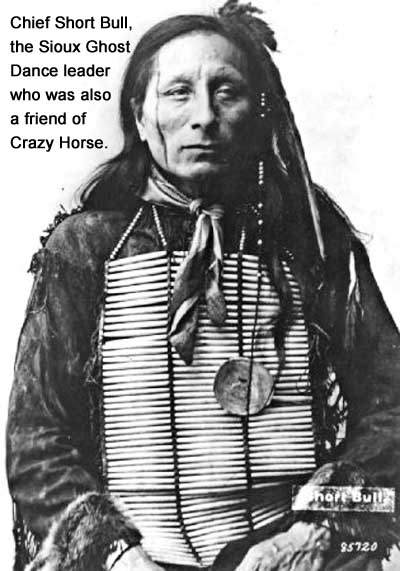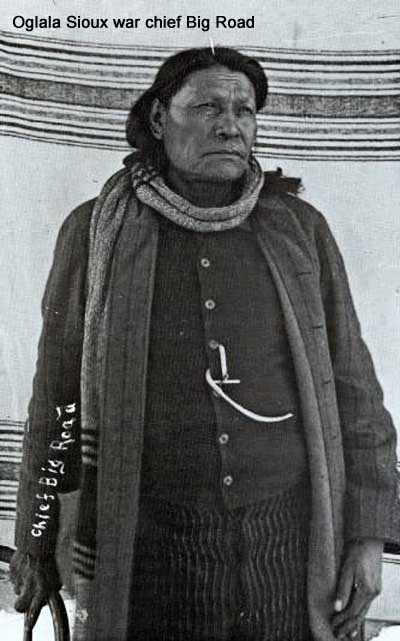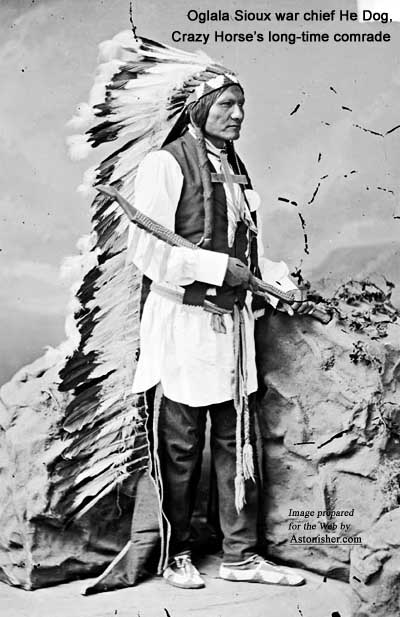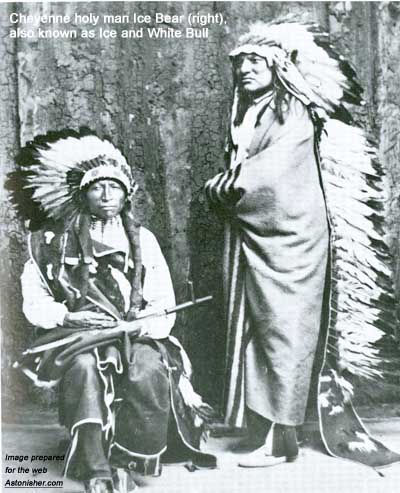|
||||||||||||
Bruce Brown's 100 Voices... Grant Short Bull on Crazy Horse
Crazy Horse and his younger brother [Little Hawk] were guarding the rear of their war party. After a lot of fighting, Crazy Horse's pony gave out. Crazy Horse turned it loose and the younger brother, who did not want to leave him, turned his own pony loose. Two of the enemy, mounted, appeared before them for single combat. Crazy Horse said to his brother, "Take care of yourself, I'll do the fancy stunt." Crazy Horse got the best of the first Shoshone, the other one ran away. He got the horses of the two Shoshones and they caught up with their party. They had saved themselves and their party and got the two horses and the scalp of the Shoshone who was killed. This happened near the present agency. Another time when the Crows pretty nearly got Crazy Horse was the fight on Arrow Creek, the same fight where Runs Fearless performed his great deed. Crazy Horse charged the Crows, his horse was shot under him, and he was surrounded by the enemy. The Oglalas tried to help him but could not get near him. A man named Spotted Deer made a last effort to reach him. He broke through the enemy and Crazy Horse got onto his pony behind him and they made a charge for the open. They both made it back to the Sioux lines, riding double and closely pursued. This battle is known to the Indians as "The Time Yellow Shirt Was Killed By The Crows". Pictures of it are shown in the Bad Heart Bull manuscript. Yellow Shirt was a member of the White Horse Owners society. That is, he was one of the shirt wearers of the Northern Montana Sioux. At the time of this battle, Crazy Horse and He Dog were the two lance bearers of the Has-The-Crow-Skin (Crow Owners) Society. Short Buffalo was asked to tell about what happened from the time the hostiles decided to come in to the agency until Crazy Horse was killed. His narrative follows: About one hundred men went out from the agency to coax the hostiles to come in under pretense that the trouble about the Black Hills was to be settled. The bands of Cra The next spring He Dog and the Cheyennes were camped on Powder River, working in slowly toward the agency. Early one morning a lot of soldiers sent by Gen. Crook jumped them and took away everything they had, tipis, clothing, food, everything. Crazy Horse was camped a little further down the same river. He Dog and the Cheyenne were going toward him but had not yet reached him when they were jumped by the soldiers. The chiefs of the Cheyenne with He Dog were Little Wolf and Ice. A man by the name of Crawler had come out from the reservation and brought a message from Red Cloud, saying, "It is Spring; we are waiting for you." Crawler was fired on too, although he came out there on behalf of the white people. (This is the Powder River fight of March 17, 1876. The whites thought they had hit Crazy Horse. For a white account, see Bourke, J.M., "On the Border with Crook") This attack was the turning point of the situation. The following summer Crooke attacked us and then Custer got into it. If it had not been for that attack by Crook on Powder River, we would have come in to the agency that Spring, and there would have been no Sioux war. The first message we got that Custer was coming to fight us was early in the summer. A small band of Indians coming from North Dakota came in and told about an encounter with Custer. One of this band cited for great bravery in that encounter was named Long Elk (These were apparently the Yanktons under Inkpaduta.) After they joined us we left that place and moved over onto the next river, The Rosebud. Here the Cheyennes joined us. They came north past Ft. Laramie. What they reported was that a lot of soldiers were massing at Ft. Laramie and that Crook had enlisted a lot of Crows and Shoshones and was coming up North to capture all the Sioux. So it wasn't long until we had a fight with Crook on the Rosebud and pushed him back. The Crows, Shoshones, and Crook together made up a strong force. In the Rosebud fight the soldiers first got the Sioux and the Cheyenne on the run. Crazy Horse, Bad Heart Bull, Black Deer, Kicking Bear and Good Weasel rallied the Sioux, turned the charge and got the soldiers on the run. Good Weasel was a kind of lieutenant for Crazy Horse, he was always with him. When these five commenced to rally their men, that was as far as the soldiers got. Crook moved back to Goose Creek after the fight. If he had got word to Custer, he could have told him that there were a lot of us Sioux. But he didn't get word to him. Crazy Horse used good judgment in this Rosebud fight. Six days after the Rosebud fight, Custer ran into us. In this Custer fight I was helping fight Reno and never noticed Custer coming. We had Reno's men on the run across the creek when Crazy Horse rode up with his men. "Too late! You've missed the fight!" we called out to him. "Sorry to miss the fight!" he laughed, "But there's a good fight coming over the hill." I looked where he pointed and saw Custer and his bluecoats pouring over the hill. I thought there were a million of them. "That's where the big fight is going to be," said Crazy Horse. "We'll not miss that one." He was not a bit excited, he made a joke of it. He wheeled and rode down the river and a little while later I saw him on his pinto pony leading his men across the ford. He was the first man to cross the river. I saw he had the business well in hand. They rode up the draw and then there was too much dust, I could not see any more. The next day we saw Bear Coat (The Indian name of General Miles, but Short Buffalo obviously means Gen. Terry, more commonly called the Limping Soldier, or One With No Hip) coming from below along the river. These soldiers are the ones that dug in the ground and didn't do much fighting. In the morning they joined forces with Reno on his hill. The Indians quit and went away. There had been three armies after us, Crook, Custer and Bear Coat (Terry). If all three forces had struck together it might have been a different story. But each struck separately.
(Here the interpreter, John Colhoff put in a word, saying that he had read in a book that the Chief American Horse was mortally wounded and taken prisoner in this battle, but that was a mistake. American Horse was not taken prisoner in this battle, neither did he die of wounds received there. Short Buffalo confirmed the younger man in this. Asked who the man was who was shot through the intestines while concealed in the sand pit, and who died that night and was left for the Indians to bury, Short Buffalo replied: Iron Plume was the man shot in the sand pit. There were women in that pit too. Iron Plume didn't give up until he was too badly wounded to live. It was Iron Plume, not American Horse One woman was wounded, they let the injured woman and the dead man's wife go. Three women and one child were found dead after the battle. The story might have been different here too, but most of the men were out trading for ammunition when the attack came, and they had not got back.) After this we went North to the Tongue River and sent eight men to make a treaty. Our peace envoys ran into the Crow camp and lost five men. The other three came home. Then we had the fight where Big Crow got killed. Crazy Horse was in this fight although I did not see him. His horse was killed under him. He was one of four men who served as a rear guard to cover the retreat of the others and then made their get away. The Big Crow who gave his name to this fight was a Cheyenne. The Cheyenne spent that winter with Crazy Horse and He Dog. (Short Buffalo was asked if there was anything to the story that Crazy Horse had refused to share his scanty supplies with the Cheyenne refugees from the Battle of Hole-in-the-Wall, led by Dull Knife, and that they were at enmity with him on this account. This story is told by Maj. Bourke in "On the Border With Crook", page 394, and denied by George Bird Grinnell, on the strength of Cheyenne testimony, in "The Fighting Cheyennes", page 368. Short Buffalo said: There is nothing to that story. We helped the Cheyenne the best we could. We hadn't much ourselves.) After that we started toward the Rocky Mountains to hunt. An Indian half breed named Big Leggings (John Brughier) brought back three women captives taken by Gen. Miles and asked the hostiles to consider peace. Big Leggings, was interpreter for Gen. Miles--a Hunkpapa. His coming to us that way was a brave deed. He would have been killed, but He Dog protected him until the ill feeling was over. There was always a pretty good bunch of men hanging around He Dog in those days. As soon as people know what Big Leggings came for, and that the women had not been hurt, then it was all right. (For a further account of this incident see Gen Nelson Miles, Personal Recollections, pages 239-240.) While we were up there, Crow Hawk, Running Fire, and Sword came out to us with a message. They wanted us to come back to the Red Cloud Agency and quit fighting. When the messengers came to He Dog we learned that Crazy Horse had already come down to Lodgepole Creek near the Powder River; he was already moving toward the agency. So at this Powder River we all met and had a big council and decided to go in together.
On a big flat near Ft. Robinson, Red Cloud and White Hat (Lt. Clark) and two troops of cavalry met Crazy Horse. They shook hands and said they were glad to see him; everybody had come in peace. Crazy Horse spread out his blanket for Red Cloud to sit on and gave his shirt to Red Cloud; He Dog did the same for White Hat. This meant that they gave up to these two. He Dog gave his war horse and saddle to White Hat. You can see by this that there was no ill feeling toward the whites. In all the talk they had on this day, Crazy Horse said, "There is a creek over there they call Beaver Creek; there is a great big flat west of the headwaters of Beaver Creek; I want my agency put right in the middle of that flat." He said the grass was good there for horses and game. This flat is near where the town of Gillette, Wyoming is today. After the agency was placed there he would go to Washington and talk to the Great Father. There was another site he had picked for an agency, over near the White (Bighorn) Mountains. This was near where the town of Sheridan, Wyo., is today. But if he couldn't go there, this place near Beaver Creek would be all right. This was the only cause of misunderstanding at that time. Crazy Horse wanted to have the agency established first and then he would go to Washington. The officers wanted him to go to Washington first. The difference of whether Crazy Horse should go to Washington before or after the site of the agency was settled upon brought on all the trouble, little by little. When Iron White Man (a relative of Crazy Horse) made his trip to Washington, he tried to make that clear. (Apparently Crazy Horse was afraid that if he went to Washington before the site of his agency was settled upon, the authorities might try to intimidate him into signing a transfer of his people to the Indian Territory where, in fact, his allies the Cheyennes were sent in June of the same year, with disastrous consequences both to Cheyennes and to neighboring Kansas settlers. Either this or he feared that he was to be punished for the Custer affair. The Indians interviewed seem to have been reluctant to state these suspicions in so many words, to the white interviewer.) He Dog, I and all our family are related to Red Cloud. So, after a while, we naturally moved over and camped near Red Cloud. Right away after that I joined the scouts and went out with a bunch of them to try to persuade the Lame Deer band to come in. I was away on this errand when Crazy Horse was killed. So this is as far as I know about Crazy Horse. Crazy Horse was a man not very tall and not very short, neither broad nor thin. His hair was very light about the color of yours (The interviewer could be described as a medium blonde). He was a trifle under six feet tall. Bad Heart Bull was the same general type. But Crazy Horse had a very light complexion, much lighter than the other Indians. He usually wore a Iroquois shell necklace; this was the only ornament he wore. His features were not like those of the rest of us. His face was not broad, and he had a sharp, high nose. He had black eyes that hardly ever looked straight at a man, but they didn't miss much that was going on, all the same. I have seen two photographs of Crazy Horse that I think one showed him on a buckskin horse he owned, one on a roan. I think they were really him, both showing him on horseback. I have seen a third photograph that I am sure was he because it showed him on the pinto horse he rode in the Custer fight. I could not possibly make a mistake about that horse and nobody rode it but Crazy Horse. The man who owns these pictures got them from soldiers who used to be at Ft. Robinson. He has quite a collection of pictures of Chiefs. I think he lives out in California now, near the National Park there. I do not remember his name. The Nebraska Indian Wars Reader edited by R. Eli Paul, University of Nebraska Press, Lincoln, NE 1998, p 202 - 208
Short Bull or Short Buffalo (later known as John Arnold Short Bull) was He Dog's brother. His comment about Little Big Man being captured at the Battle of Slim Buttes doesn't agree with the Crazy Horse Surrender Ledger, where Little Big Man is listed among those who surrendered with Crazy Horse at Ft. Robinson in May 1877, along with Short Bull, He Dog, White Twin, Knife Chief, Black Elk and nearly 900 others. Here is Short Bull's account of the Battle of the Little Bighorn and the Battle of the Rosebud. * * * I am honored that I have received personal communication from two of Short Bull's family. Both Tim Short Bull and Dr. Lisa Short Bull, both direct descendents of John Arnold Short Bull, the Ghost Dancer, shared information that has made this article more accurate. Thanks to both!
|
||||||||||||




 I WILL TELL you about one of the war stunts that
I WILL TELL you about one of the war stunts that  zy Horse,
zy Horse,  The day we saw Bear Coat (Terry), Crazy Horse was in charge. He placed scouts to see Bear Coat did not follow us. But he did not. His soldiers made racks (litters) and hauled the wounded to the mouth of the Bighorn. I was one of the scouts who saw this and reported to Crazy Horse.
The day we saw Bear Coat (Terry), Crazy Horse was in charge. He placed scouts to see Bear Coat did not follow us. But he did not. His soldiers made racks (litters) and hauled the wounded to the mouth of the Bighorn. I was one of the scouts who saw this and reported to Crazy Horse.  The Cheyenne Chiefs,
The Cheyenne Chiefs, 







